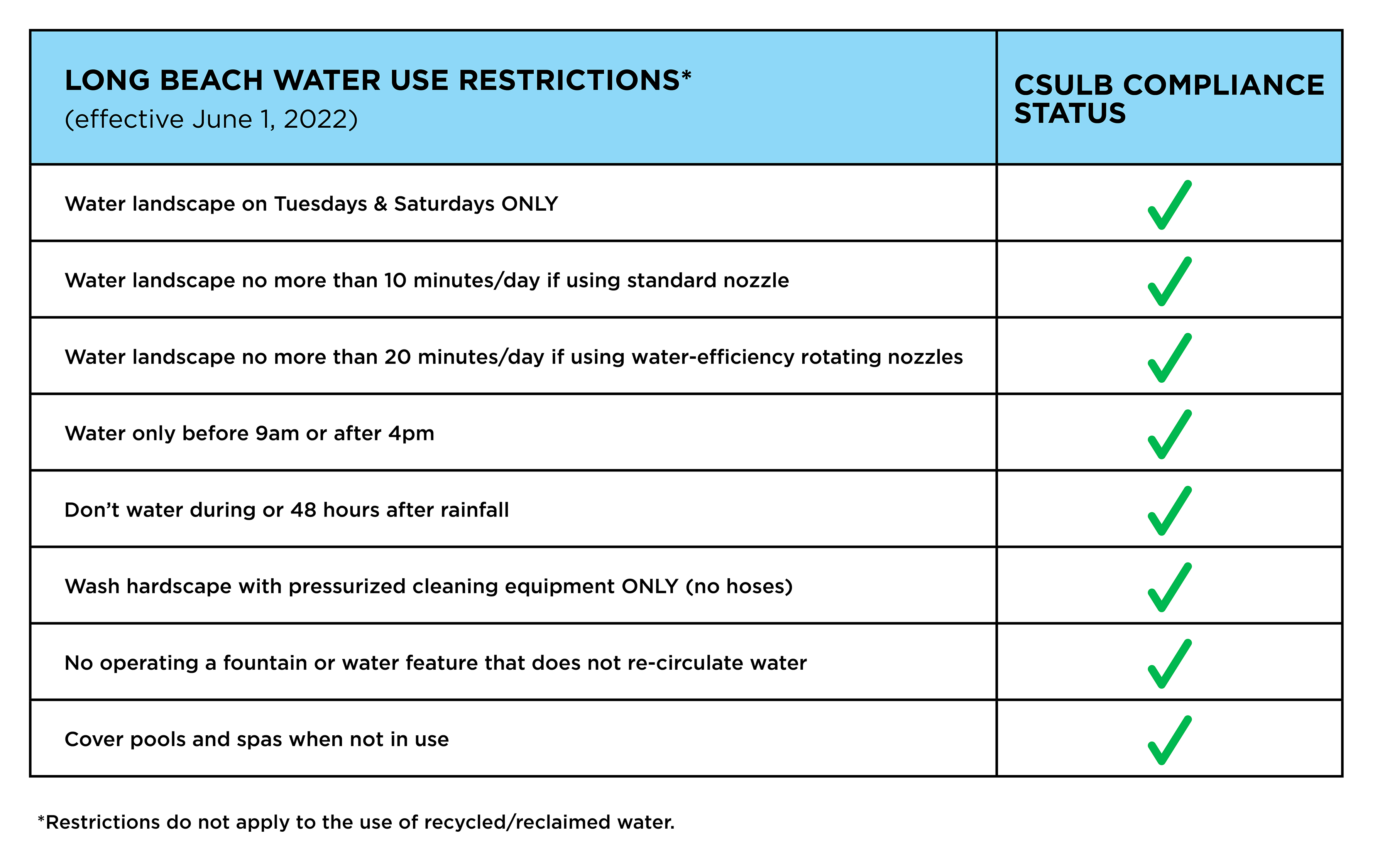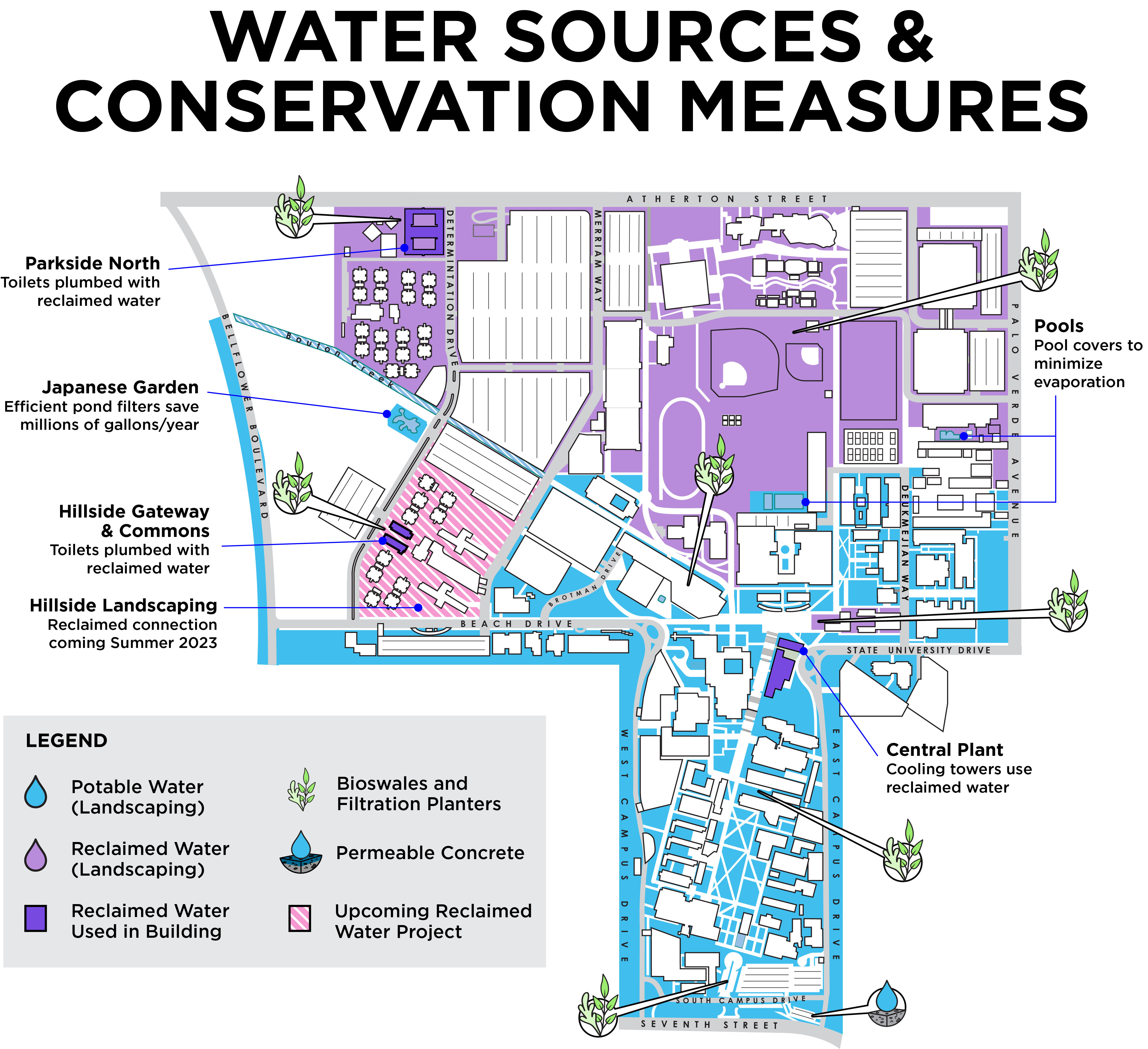Drought Response
In response to the severe and ongoing drought in California, the Long Beach Board of Water Commissioners declared a Stage 2 Water Supply Shortage in May 2022. The Long Beach Water department in turn issued the following water use restrictions to which the university has taken the necessary steps to comply.

The university recognizes the importance of conserving as much water as possible while maintaining a campus environment that supports student success and wellness. The sections below detail the measures CSULB is taking to respond to the drought and engage students, faculty and staff in our conservation efforts.
Maintaining the campus’ beautiful, park-like environment, urban forest and turf fields used for athletics requires significant amounts of water. The university takes the following steps to ensure that water used for landscape irrigation, especially potable water, is conserved as much as possible:
-
The campus’ centralized irrigation system includes 74 remote, programmable irrigation satellites that allow watering schedules to be precisely controlled to optimize efficiency.
-
The campus’ weather station is equipped with evapotranspiration monitoring capabilities which track real-time moisture levels to prevent over-watering.
-
The weather station has a “rain shutdown” function that automatically turns off the central irrigation system to prevent unnecessary watering during rainy days.
-
A goal of the Climate Action and Adaptation Plan is to finish the work of converting all landscape irrigation spray nozzles to more efficient MP rotator nozzles to help reduce water runoff.
-
Campus wide visual inspections are conducted daily to check for leaks and broken sprinkler heads
-
Campus wide irrigation system audits are performed every 3 months to identify opportunities to maximize system efficiency
While it is important to act as good stewards of all water resources, it is most critical to preserve potable (drinking) water that is needed for human survival. For this reason, the campus takes steps to prioritize the use of reclaimed (recycled) water in place of potable water whenever possible. Examples include:
-
Of the 78.2 acres of landscape maintained by the campus, over 47 acres are currently irrigated with reclaimed water, including all 23.7 acres of turf athletic fields.
-
A 2018 project connected the central plant cooling towers to the reclaimed water system and installed a pump system and piping for future expansion of the system to upper campus.
-
A 2021 project expanded the reclaimed water distribution line to allow for future conversion of all 6.2 acres of Hillside Student Housing landscape irrigation from potable to reclaimed water.
-
A goal of the Climate Action & Adaptation Plan is to complete the expansion of the reclaimed water system across the entire campus.
-
A 2022 Utility Master Plan study (currently underway) will aid in formulating a plan and strategy for expanding the reclaimed water system throughout campus.
Although landscape irrigation is the university’s number one water use, a significant amount of water is also used in toilets, sinks, and showers throughout campus. For this reason, the university has taken steps to convert all fixtures to the most water efficient models available. Some examples of these efforts include:
-
$44,000 in water rebates were leveraged to replace 225 standard flow toilets in multiple campus buildings with high efficiency 1.28 gallon per flush toilets. This change saves an estimated 3 million gallons of potable water annually.
-
A 2014 project retrofitted toilets, showerheads, and sinks in Student Housing facilities, resulting in approximately 6 million gallons of potable water savings annually.
-
The Parkside North Residential Housing opened in 2021 and was one of the first buildings on a CSU campus to use reclaimed water for toilet flushing.
-
A 2017 project in the Student Recreation and Wellness Center converted its standard 2.5 gallon per minute showerheads in the locker rooms to more efficient 1.5 gallon per minute models.
-
A 2022 project in the University Student Union replaced the automatic faucets, which were malfunctioning and causing excessive amounts of overspray and water waste, with more functional fixtures.
-
The Residential Dining Halls in Parkside, Hillside, and Beachside, and the Retail Dining locations of the Outpost and University Dining Plaza worked with the City of Long Beach’s Certified Blue Restaurant Program to implement the water efficiency recommendations in their food preparation kitchens.
Water is also used to enhance the aesthetic beauty of the campus, provide pools for recreation and athletics, and create habitat for various species. Some of the ways that water conservation is considered in relation to these uses include:
-
The decorative fountains at Brotman Hall, Macintosh Humanities Building, and inside the courtyard of the student union use recirculated water. The fountains are often shut off during the summer and winter breaks.
-
The swimming pools located at the Student Recreation and Wellness Center, University Student Union, and Kinesiology building utilize pool covers when not in use to minimize evaporation, allowing them to be refilled less often.
-
A 2017 project at the Earl Burns Miller Japanese Garden replaced and upgraded the old sand filters in the koi pond with high efficient bio-mechanical filters. At the same time, the sprinkler heads at the garden were replaced with more efficient MP rotator heads. These two upgrades resulted in approximately 2.4 million gallons saved annually.
The university is committed to working with on and off campus partners to promote a shared vision for water conservation and involving students in hands-on projects that reduce our water use. Examples of our efforts in these areas include:
-
Coordinating a Water Conservation Working Group with representation from Beach Building Services, Housing, ASI, BeachShops, Foundation and Long Beach Water department to share best practices and requirements across the university.
-
“Campus as a Living Lab” projects in 2015 and 2017 in which students worked with the Landscaping & Grounds department to map the campus irrigation system. These maps are used daily by Grounds staff to manage water use on campus and as a tool to identify areas of opportunity to improve system performance and advance water conservation efforts.






